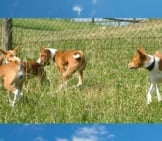The Basenji is infamously known as the barkless dog. While this is true, it is rather misleading. These dogs do make a variety of sounds to express their emotions, though none are a familiar woof. This title does betray the Basenji’s unique past. These ancient dogs are a product of Africa, and are nothing like most European breeds. Often likened to felines, these dogs make extremely unique pets. Read more to learn about the Basenji.
Description of the Basenji
This breed resembles the sleek dogs depicted in ancient Egyptian paintings. Slender yet sturdy, the Basenji is not big, but well proportioned. They have jackal-like snouts, large ears, and beautiful eyes.
Their familiarity is no coincidence. These dogs were brought to ancient Egypt, where they achieved worldwide fame, from further south in Africa. It took many years for them to spread elsewhere, as Europe had a particularly hard time breeding the beguiling dog. Eventually, though, the Basenji set up shop in America and became something of a cult classic.
This breed features a short coat with a classic red and white pattern. However, they also come in black and white; black, tan, and white; and brindle and white colorations.
Life Expectancy and Size
These dogs stand between 16 and 17 inches tall, only weighing between 22 and 24 pounds. They are slender yet athletic, with very long legs.
The Basenji usually lives between 13 and 14 years. Because of some unique health problems, they are not as long-lived as some dogs of their size.
Protective Ability
This breed makes an attentive watchdog. Naturally wary of strangers, these dogs will alert you to any breach in the perimeter. They tend to be territorial, so early socialization is key. Still, they will enjoy using their competent ears and eyes to search out the bad guys.
Training
Perhaps calling attention to the Basenji’s feline characteristics can be intimidating in terms of training. Indeed these dogs are sometimes too smart for their own good, and bore easily. However, do not let that deter you. A competent owner can take advantage of these traits instead of being scared by them.
Short training sessions will keep the Basenji’s attention and allow him to succeed. Generally, positive reinforcement will be enough to motivate him. However, treats can be another good way to convince this opinionated dog that your request is really in his best interest. Consistent reward- and relationship-based training is the key to success.
Energy Level
This breed is perpetually alert and attentive. They enjoy putting their noses to the ground and exploring. The Basenji isn’t as interested in running himself to the ground, as constantly fulfilling his curious nature. Intellectual stimulation is equally important as athletic pursuits.
What Living with a Basenji is Like
These dogs are an enigma. Certainly, living with a Basenji is a unique experience. Besides their barkless yodeling sounds, they are very different than most canines. Alert and energetic, they are also strangely intense and reserved with strangers.
This breed is good for owners that enjoy their unique mentality. They may not be as profusely loving as a Pug or as loyal as a Bernese Mountain Dog. However, many owners find enjoyment in their expressive, yet aloof attitudes. These dogs are not short on personality.
It is very important to keep the Basenji mentally stimulated. Otherwise, they will likely find ways to express themselves. This could include scaling 6-foot fences!
Care of the Basenji
Caring for the Basenji is not difficult, as long as you can provide them adequate mental and physical stimulation.
Environmental Needs
The Basenji does not have any specific environmental needs beyond the obvious. As a small, short haired breed, they may require more attention in the cold. Try to provide a sheltered area out of the cold and wet. Of course, always offer enough clean water.
Exercise Needs
This breed requires adequate physical activity to avoid boredom. This does not necessarily need to come in the form of intense sessions. However, the Basenji’s exercise regimen should include mental stimulation.
Play sessions in the yard can be a great place to start. A brisk run or walk can also be good, although the Basenji is notoriously mischievous off leash.
These dogs tend to enjoy structure, so that they feel a job has been completed. Some individuals enjoy canine sports like agility or obedience.
Shedding and Grooming
This breed has an easy care coat. They do shed, but only minimally. Brushing weekly or biweekly with a soft brush or mitt can keep this under control. It will also give their short coat a lovely sheen.
The Basenji is blessed with a mild odor that rarely broaches on doggy. Baths are only necessary when they get into something truly nasty.
Ideal Home Environment
Much like a cat, the Basenji deserves a home that will appreciate his regal aloofness. Smart and expressive, there is no denying that these dogs have personality. However, it is expressed very differently than in most family pets. Basenjis are not for families that want unconditional cuddling.
They will do well with owners that enjoy entertaining their curiosity. They should have access to a secure yard.
Early socialization is important to limit their natural wariness of strangers.
Health Concerns
Most health conditions that plague the Basenji can be screened for by responsible breeders. Thus, is extremely important to obtain this breed from a reputable source.
These dogs may suffer from hypothyroidism or inflammatory bowel disease. Other common issues include hip, knee, and eye issues. These are generally no more severe than in most breeds.
Behavior Problems
To avoid behavioral issues with this breed, it is essential to keep them entertained and active. A bored Basenji is a destructive Basenji. These dogs will quickly turn to negative behavior like chewing. They are great jumpers and may easily turn into escape artists. Remember that the easiest way to adjust this behavior is to channel the Basenji’s energy into positive channels.
























![Red Angus Closeup of a beautiful Red Angus cowPhoto by: U.S. Department of Agriculture [pubic domain]https://creativecommons.org/licenses/by/2.0/](https://animals.net/wp-content/uploads/2020/03/Red-Angus-4-100x75.jpg)

